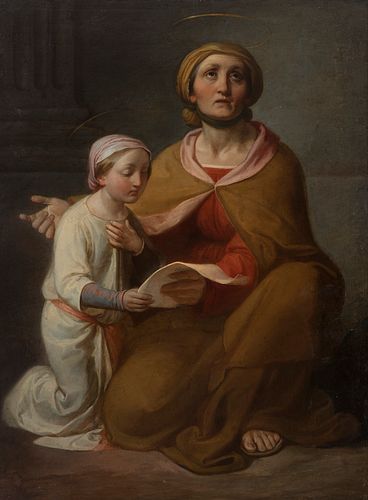French School; circa 1805. "The Education of the Virgin. Oil on canvas. Relined. Size: 99 x 79 cm; 106,5 x 81,5 cm (frame).
Lot 112
About Seller
Setdart Auction House
Carrer Aragó 346
Barcelona
Spain
Setdart Subastas was born in 2004 and is currently the first online art auction in Spain with solidity, prestige and reliability guaranteed by our more than 60,000 users. Setdart has a young, dynamic and enterprising team ready to successfully manage the purchase and sale of art works through custom...Read more
Estimate:
EUR€12,000 - EUR€14,000
$12,903.23 - $15,053.76
Absentee vs Live bid
Two ways to bid:
- Leave a max absentee bid and the platform will bid on your behalf up to your maximum bid during the live auction.
- Bid live during the auction and your bids will be submitted real-time to the auctioneer.
Bid Increments
| Price | Bid Increment |
|---|---|
| EUR€0 | EUR€10 |
| EUR€200 | EUR€25 |
| EUR€500 | EUR€50 |
| EUR€1,000 | EUR€100 |
| EUR€3,000 | EUR€200 |
| EUR€5,000 | EUR€500 |
| EUR€10,000 | EUR€1,000 |
| EUR€20,000 | EUR€2,000 |
| EUR€50,000 | EUR€5,000 |
About Auction
By Setdart Auction House
Oct 20, 2021
Set Reminder
2021-10-20 07:30:00
2021-10-20 07:30:00
America/New_York
Bidsquare
Bidsquare : OLD MASTERS
https://www.bidsquare.com/auctions/setdart-auction-house/old-masters-7700
Setdart Auction House sofia@setdart.com
Setdart Auction House sofia@setdart.com
- Lot Description
French School; circa 1805. "The Education of the Virgin. Oil on canvas. Relined. Size: 99 x 79 cm; 106,5 x 81,5 cm (frame). Through soft and velvety brushstrokes the artist represents the religious theme of the education of the Virgin. It is a scene in which the Virgin shows Saint Anne teaching Mary her first letters, a theme that does not arise from Gospel literature but from the popular desire to emphasise the role of the mother's line in the human education of the Son of God, a desire that also made Saint Anne the patron saint of mothers. It is therefore a common and traditionally accepted theme, despite the fact that the Scriptures tell us that the infant Virgin was given to the temple for her upbringing. It is an iconography that appeared at the end of the Middle Ages and became popular from the 16th century onwards, with the book appearing as an attribute of Saint Anne from that time onwards. This theme was the focus of intense discussion in intellectual circles in Seville during the Baroque period. As part of the Counter-Reformation doctrine, the Church dictated a series of rules to painters aimed at regulating the treatment of the most fundamental themes of Catholic doctrine so that they could be understood by the people. In particular, the Virgin became one of the most popular subjects among the Catholic faithful, as her immaculate conception was questioned by Protestants. Hence the proliferation in the 17th, 18th and early 19th centuries of cycles of the Virgin's life, one of the scenes of which concerns her education. Although this theme aroused controversy among intellectuals, because it cast doubt on Mary's perfection, it was very much to the taste of the people because of its human and realistic character. Aesthetically, the work is related to Pierre Paul Prud'hon, a French painter and draughtsman who achieved great fame through portraiture and the depiction of allegories. He began his painting studies in Dijon, but later moved to Rome thanks to a scholarship offered by the French government. It was during his stay in the Eternal City that he was influenced artistically by the works of artists such as Corregio and Leonardo, despite the fact that at the time classicism dominated by Canova prevailed. On his return to France he came into contact with Napoleon's court, thus achieving great success among the high society of the time. Today many of his works belong to the most important collections, such as the Hermitage Museum in Saint Petersburg, the Louvre in Paris, the J. Paul Getty Museum in Los Angeles, the Fine Arts Museum in San Francisco, the Art Institute of Chicago, the Kunsthistorisches Museum in Vienna, the Metropolitan Museum of Art in New York, the Wallace Collection in London, etc.
- Shipping Info
-
In-house shipping available. Please inquire at admin@setdart.com.
-
- Buyer's Premium



 EUR
EUR CAD
CAD AUD
AUD GBP
GBP MXN
MXN HKD
HKD CNY
CNY MYR
MYR SEK
SEK SGD
SGD CHF
CHF THB
THB









